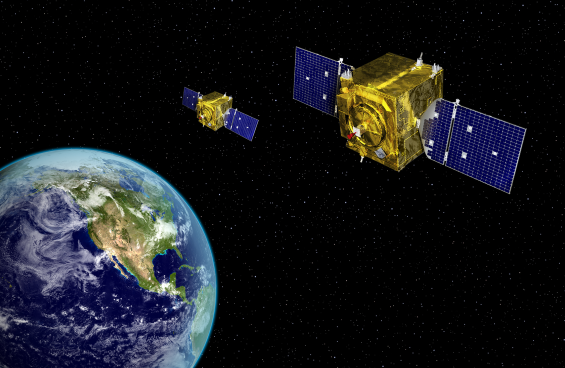
Northrop Grumman also makes Geosynchronous Space Situational Awareness Program satellites for the U.S. Space Force.
IHI Corporation of Japan and Northrop Grumman have signed a memorandum of understanding to develop “highly maneuverable” small satellites, as well as other technologies, for space domain awareness missions for the Japanese government.
The satellites are to “enhance awareness in an increasingly contested geosynchronous Earth orbit environment,” Northrop Grumman said March 15.
Both companies point to a call within Japan’s National Security Strategy and National Defense Strategy, released in December, for stronger space situational awareness. The signing ceremony at the DSEI Japan exhibition in Tokyo was attended by U.S. Ambassador to Japan Rahm Emanuel and a government official from the Japanese Ministry of Defense’s Department of Equipment Policy, Acquisition, Technology & Logistics.
“Recently, we have seen a rise in military surveillance efforts from other countries, which is becoming a national security threat,” says Fumiharu Namiki, vice president of the aero engine, space and defense business area within IHI.
The jointly developed space situational awareness satellites will use existing Northrop Grumman buses, though the type was not disclosed.
Subsidiary IHI Aerospace has long provided propulsion systems to Northrop Grumman’s commercial satellites and spacecraft. The Japanese company makes bipropellant, monopropellant, green propellant, cold gas and electric propulsion systems.
Northrop Grumman has built and launched multiple Geosynchronous Space Situational Awareness Program (GSSAP) satellites for the U.S. Space Force, most recently in 2022 when two of the type were launched. The GSSAP satellites operate near the geosynchronous belt and surveil other spacecraft with rendezvous and close proximity flying.
Northrop Grumman, through its subsidiary SpaceLogistics, is also working on developing in-orbit servicing and refueling spacecraft. In October, the company said it had won a contract from the Space Force to install hydrazine refueling valves on unnamed, not-yet-launched operational satellites.
The Space Force wants to refuel its satellites on orbit to allow the spacecraft to maneuver rapidly, for example, to dodge Chinese and Russian ground-launched anti-satellite missiles, as well as to avoid the gaze of spy satellites or the grasp of spacecraft with robotic arms. Defensive maneuvers use up precious fuel that would otherwise be needed for a satellite’s core mission, shortening its life span.
